大麻油提取工艺及木质纤维素残留物的潜在应用。生物炼制概念下的技术经济评估
Q1 Environmental Science
引用次数: 0
摘要
本研究对大麻油提取工艺进行了研究和评价。首先利用NREL协议对大麻进行了木质纤维素生物质组成的表征,同时利用FTIR、气相色谱(GC-FID)和固相微胶囊萃取(SPME)对其油成分进行了表征。随后,在哥伦比亚的情况下,对使用超临界二氧化碳提取大麻油的过程进行了模拟,并进行了技术经济评估(TEA)和生命周期评估(LCA),考虑了大麻植物的能力和品种的几种情况。结果表明,该油中纤维素、半纤维素和木质素的含量分别为32.04%(±0.045)、14.21%(±0.029)和7.47%(±0.020),四氢大麻酚含量为27.7%,CBD含量为1.1%,石竹烯(7.74%)和松油醇(4.61%)等萜烯含量较高。技术经济评价表明,富cbd油的生产成本为6.71 ~ 11.15美元/kg,富thc油的生产成本为2.05 ~ 3.42美元/kg, LCA对气候变化有重要影响。本文章由计算机程序翻译,如有差异,请以英文原文为准。

Cannabis oil extraction process and potential applications of lignocellulosic residues. A techno-economic assessment under the biorefinery concept
This research studied and evaluated a Cannabis sativa L. oil extraction process. Cannabis sativa L. was first characterized based on its lignocellulosic biomass composition using the NREL protocols while oil composition was characterized by FTIR, Gas Chromatography (GC-FID) and Solid Phase Microencapsulation Extraction (SPME). Afterwards, a process simulation of a cannabis oil extraction using supercritical CO2 was performed along with a techno-economic assessment (TEA) and a life cycle assessment (LCA) in the Colombian context, considering several scenarios for capacities and varieties of cannabis plant. Results demonstrated that lignocellulosic content was 32,04 % (±0,045), 14,21 % (±0,029), and 7,47 % (±0,020) for cellulose, hemicellulose, and lignin, respectively while the oil showed 27,7 % of THC, 1,1 % of CBD, and high content of terpenes such as caryophyllene (7,74 %) and terpinol (4,61 %). The techno-economic assessment revealed that the production cost of CBD-rich oil ranged from 6.71 to 11.15 USD$/kg, while for THC-rich oil it ranged from 2.05 to 3.42 USD$/kg and LCA as well as an important effect over climate change category.
求助全文
通过发布文献求助,成功后即可免费获取论文全文。
去求助
来源期刊

Bioresource Technology Reports
Environmental Science-Environmental Engineering
CiteScore
7.20
自引率
0.00%
发文量
390
审稿时长
28 days
 求助内容:
求助内容: 应助结果提醒方式:
应助结果提醒方式:


